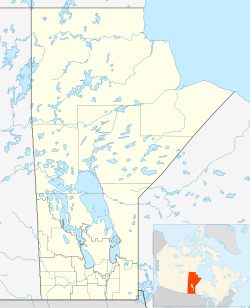St. François Xavier, Manitoba
St. François Xavier | |
|---|---|
Unincorporated urban centre | |
 St. François Xavier Location of St. François Xavier in Manitoba | |
| Coordinates: 49°54′46″N 97°32′30″W / 49.91278°N 97.54167°WCoordinates: 49°54′46″N 97°32′30″W / 49.91278°N 97.54167°W | |
| Country | |
| Province | |
| Region | Central Plains and Winnipeg Metro |
| Census Division | No. 10 |
| Municipality | RM of St. François Xavier |
| Founded | 1824 |
| Post office established | 1871 |
| Area | |
| • Land | 3.38 km2 (1.31 sq mi) |
| Population | |
| • Total | 662 |
| • Density | 195.8/km2 (507/sq mi) |
| Time zone | UTC−6 (CST) |
| • Summer (DST) | UTC−5 (CDT) |
| Forward sortation area | R4L |
| Area code(s) | 204 |
St. François Xavier is an unincorporated urban centre located in the Rural Municipality of St. François Xavier, Manitoba, Canada. It is located about 15 km west of the city of Winnipeg on the Assiniboine River.
Settled around 1824 as Grantown, it is the second oldest settlement in Manitoba.[3]
History[]

The area of current-day St. François Xavier, commonly known as White Horse Plains (La Prairie du Cheval Blanc), was home to several different First Nation tribes like the Cree and the Dakota, as the lands in the area provided for a rich harvest of buffalo and a number of other animals.[4]
Around 1824, Cuthbert Grant, who had recently led the Métis in the Battle of Seven Oaks, arrived in the area and was soon joined by many Métis families. The settlement was thereby founded, and named Grantown after Grant.[5]
The Métis have since had a noticeable role in the municipality and throughout the province.
In 1851, Father Louis-François Richer Laflèche accompanied the Métis buffalo hunters from the Parish of St. François Xavier on one of their annual hunts on the prairies. The hunting group, led by Jean Baptiste Falcon, son of Pierre Falcon (a Métis songwriter),[6] was made up of 67 men, a number of women who came to prepare the meat, some small children and 200 carts. In North Dakota they encountered a band of Sioux. Laflèche dressed only in a black cassock, white surplice, and stole, directed with the camp commander Jean Baptiste Falcon a miraculous defence against 2,000 Sioux combatants, using a crucifix at the Battle of Grand Coteau in North Dakota. After a siege of two days (July 13 and 14), the Sioux withdrew, convinced that the Great Spirit protected the Métis.[7][8]
The St. François-Xavier post office was opened in 1871 and closed in 1975.[9]
Demographics[]
St. François Xavier is classified as an unincorporated urban centre and is a designated place in the Canadian census. In 2011, it had a population of 1,240 which was down 8.5% from 2006. The land area was 3.37 km2.[10] As of the 2016 Census, the population was 1,411.[11]
Notable people[]
Notable people buried at the St. Francois Xavier Roman Catholic Church and Cemetery include:[12]
See also[]
References[]
- ^ St. Francois Xavier, Unincorporated urban centre, Manitoba and Manitoba | Census Profile, 2016 Census." Statistics Canada.
- ^ "Population and dwelling counts, for Canada and census subdivisions (municipalities), 2011 and 2006 censuses". Statistics Canada, 2011 Census. 2014-04-28. Retrieved 2014-08-02.
- ^ "Rural Municipality of St. François Xavier | Visiting". www.rm-stfrancois.mb.ca. Retrieved 2021-08-13.
- ^ "Rural Municipality of St. François Xavier | About". www.rm-stfrancois.mb.ca. Retrieved 2019-09-26.
{{cite web}}: CS1 maint: url-status (link) - ^ "Memorable Manitobans: Cuthbert James Grant (1793-1854)". Manitoba Historical Society by William Morton. Retrieved 2014-04-27.
- ^ Barkwell, Lawrence J. "Jean Baptiste "Che-ma-na" Falcon. (b.1826)". Retrieved 2014-01-05.
- ^ "The Battle at the Grand Coteau: July 13 and 14, 1851". Manitoba Historical Society by William Morton. Retrieved 2013-10-04.
- ^ "Battle of Grand Coteau: Letter by Father Lafleche". Published by Lawrence J. Barkwell. Retrieved 2013-10-04.
- ^ National Archives, Archivia Net. "Post Offices and Postmasters (St. François-Xavier)". Retrieved 2013-04-27.
- ^ "Canada Census 2011 (community profiles)". Retrieved 2013-10-18.
- ^ Goldsborough, Gordon (2018). "Manitoba Communities: St. Francois Xavier (Rural Municipality)". Manitoba Historical Society.
{{cite web}}: CS1 maint: url-status (link) - ^ "Historic Sites of Manitoba: St. Francois Xavier Roman Catholic Church and Cemetery (St. Francois Xavier, RM of St. Francois Xavier)". www.mhs.mb.ca. Retrieved 2019-11-23.
{{cite web}}: CS1 maint: url-status (link)
- Geographic Names of Manitoba (pg. 238) - the Millennium Bureau of Canada
External links[]
- Designated places in Manitoba
- Unincorporated urban communities in Manitoba
- Unincorporated communities in Central Plains Region, Manitoba

